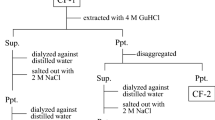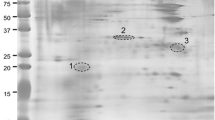Summary
We have used polyclonal antisera raised against vertebrate tenascin to identify and localize tenascin-like proteins in the developing sea urchin. These antisera recognize high-molecular weight proteins on immunoblots of sea urchin embryo homogenates that are similar in size and appearance to tenascin from vertebrates. These proteins appear as a doublet with an apparent molecular weight of 150 kDa and a larger, broad band with an apparent molecular weight of 350 kDa. Whole mounts of sea urchin embryos and larvae were stained with one of these antisera. The anti-tenascin stained the surface of primary mesenchyme cells during their phase of active migration. This staining was sensitive to detergent, suggesting that the protein recognized by the antiserum was associated with the cell surface. During later stages of development, the bulk of the antitenascin staining was found dispersed throughout the blastocoel matrix, and was no longer sensitive to detergent. We conclude that sea urchins express tenascin-like proteins during early stages of development, and that these proteins may play a role associated with primary mesenchyme cell morphogenesis.
Similar content being viewed by others
References
Anstrom JA, Chin JE, Leaf DS, Parks AL, Raff RA (1987) Localization and expression of msp130, a primary mesenchyme lineage-specific cell surface protein of the sea urchin embryo. Development 101:255–265
Cavanaugh GM (1956) “Formulae and Methods”, 5th ed. Marine Biological Laboratory, Woods Hole, MA
Chiquet M (1989) Tenascin/J1/cytotactin: The potential function of hexabrachion proteins in neural development. Dev Neurosci 11:266–275
Chiquet M, Fambrough DM (1984a) Chick myotendinous antigen. I. A monoclonal antibody as a marker for tendon and muscle morphogenesis. J Cell Biol 98:1926–1936
Chiquet M, Fambrough DM (1984b) Chick myotendinous antigen. II. A novel extracellular glycoprotein complex consisting of large disulfide-linked subunits. J Cell Biol 98:1937–1946
Chiquet-Ehrismann R, Mackic EJ, Pearson CA, Sakakura T (1986) Tenascin: An extracellular matrix protein involved in tissue interactions during fetal development and oncogenesis. Cell 47:131–139
Chiquet-Ehrismann R, Kalla P, Pearson CA, Beck K, Chiquet M (1988) Tenascin interferes with fibronectin action. Cell 53:383–390
DiSimone DW, Spiegel E, Spiegel M (1985) The biochemical identification of fibronectin in the sea urchin embryo. Biochem Biophys Res Comm 133:183–188
Erickson HP, Bourdon MA (1989) Tenascin: An extracellular matrix protein prominent in specialized tissues and tumors. Ann Rev Cell Biol 5:71–92
Erickson HP, Lightner VA (1988) Hexabrachion protein (tenascin, cytotactin, brachionectin) in connective tissue, embryonic brain, and tumors. Adv Cell Biol 2:55–90
Friedlander DR, Hoffman S, Edelman GM (1988) Functional mapping of cytotactin: proteolytic fragments active in cell-substrate adhesion. J Cell Biol 107:2329–2340
Gulcher JR, Nies DE, Marton LS, Stefansson K (1989) An alternatively spliced region of the human hexabrachion contains a repeat of potential glycosylation sites. Proc Natl Acad Sci USA 86:1588–1592
Halfter W, Chiquet-Ehrismann R, Tucker RP (1989a) The effect of tenascin and embryonic basal lamina on the behavior and morphology of neural crest cells in vitro. Dev Biol 132:14–25
Halfter W, Reinhard E, Liverani D, Ortmann R, Monard D (1989b) Immunocytochemical localization of glia-derived nexin, laminin and fibronectin on the surface or extracellular matrix of C6 rat glioma cells, astrocytes and fibroblasts. Eur J Neurosci 1:297–308
Jones FS, Burgoon MP, Hoffman S, Crossin KL, Cunningham BA, Edelman GM (1988) A cDNA clone for cytotactin contains sequences similar to epidermal growth factor-like repeats and segments of fibronectin and fibrinogen. Proc Natl Acad Sci USA 85:2186–2190
Katow H, Yamada KM, Solursh M (1982) Occurence of fibronectin on the primary mesenchyme cell surface during migration in the sea urchin embryo. Differentiation 22:120–124
Katow H, Hayashi M (1985) Role of fibronectin in primary mesenchyme cell migration in the sea urchin embryo. J Cell Biol 101:1487–1491
Mackie EJ, Thesleff I, Chiquet-Ehrismann R (1987) Tenascin is associated with chondrogenic and osteogenic differentiation in vivo and promotes chondrogenesis in vitro. J Cell Biol 105:2529–2579
Mackie EJ, Tucker RP, Halfter W, Chiquet-Ehrismann R, Epperlein HH (1988a) The distribution of tenascin coincides with pathways of neural crest cell migration. Development 102:237–250
Mackie EJ, Halfter W, Liverani D (1988b) Induction of tenascin in wound healing. J Cell Biol 107:2757–2767
McCarthy RA, Beck K, Burger MM (1987) Laminin is structurally conserved in the sea urchin basal lamina. EMBO J 6:1587–1593
Pearson CA, Pearson D, Shibahara S, Hofsteenge J, Chiquet-Ehrismann R (1988) Tenascin: cDNA cloning and induction by TGF-β. EMBO J 7:2977–2981
Riou J-F, Shi D-L, Chiquet M, Boucaut J-C (1988) Expression of tenascin in response to neural induction in amphibian embryos. Development 104:511–524
Spiegel E, Burger M, Spiegel M (1980) Fibronectin in the developing sea urchin embryo. J Cell Biol 87:309–313
Spring J, Beck K, Chiquet-Ehrismann R (1989) Two contrary functions of tenascin: Dissection of the active sites by recombinant tenascin fragments. Cell 59:325–334
Tan S-S, Crossin KL, Hoffmann S, Edelman GM (1987) Asymmetric expression in somites of cytotactin and its proteolglycan ligand is correlated with neural crest cell distribution. Proc Natl Acad Sci USA 84:7977–7981
Wessel GM, Marchase RB, McClay DR (1984) Ontogeny of the basal lamina in the sea urchin embryo. Dev Biol 103:235–245
Author information
Authors and Affiliations
Rights and permissions
About this article
Cite this article
Anstrom, J.A., Mackie, E.J. & Tucker, R.P. Immunohistochemical localization of a tenascin-like extracellular matrix protein in sea urchin embryos. Roux's Arch Dev Biol 199, 169–173 (1990). https://doi.org/10.1007/BF01681490
Received:
Accepted:
Issue Date:
DOI: https://doi.org/10.1007/BF01681490




